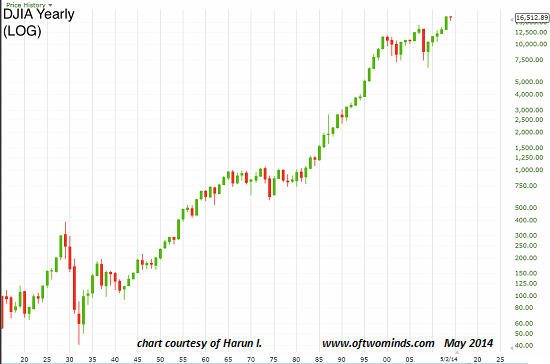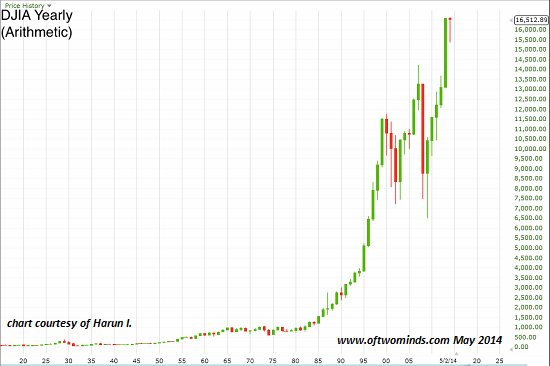A Tale of Two Charts (and Two Economies)
These two charts depict the same index (DJIA) over the same time frame, but they reflect two stories and two economies.
Long-time correspondent Harun I. recently submitted two charts of the stock market that suggest two different stories--and these two stories suggest two different economies.
The first story is the one the Federal Reserve wants us to believe: the economy is expanding smartly without inflation or deflation--in effect, a Goldilocks economy that is enabling expanding profits and margins, which have pushed stocks ever higher.
In summary, this is the happy story.
The other story is the Fed's nightmare scenario: the stock market's expansion is exhausted and poised to decline. This story is one of an economy that never expanded in meaningful fashion, and a stock market rigged to rise by unprecedented intervention (i.e.manipulation) by the Fed.
This is the not-so-happy story.
These two charts depict the same index (Dow Jones Industrial Average (DJIA) over the same time frame, but they reflect two stories and two economies. These divergent stories are possible because the data supports two parallel universes: one in which the booming market is held up as evidence the overall economy is expanding to everyone's benefit, and the other a manipulated market that has expanded not as a reflection of growth but of a staggering loss of purchasing power of the U.S. dollar and a central bank transfer of wealth from the many to the few who own the majority of financial assets.
Here is Harun's commentary:
Below are two charts of the DJIA. The periodicity is yearly, i.e. each bar is one year. One is arithmetic and one is log. They present two dramatically different perspectives.
The log chart puts gains into a relative context and I use them extensively. However, the one drawback I find is that they are a poor indicator of psychology when using the bars to gauge sentiment.
The log chart indicates nothing unusual but the arithmetic chart indicates that we should be asking ourselves whether last year’s bar suggests a high probability of exhaustion. The log chart allows the Fed and others to claim, “see, no ‘flation”, i.e., no inflation or deflation of any sort.
Yet when we look at the relative strength charts and see that when measured against gold and equities, commodities are, in many instances, at all time lows.
The cheers go up--if you are of the small percentage of people who own these assets (gold and equities). But if you are one of the 99.90%, everything has gone up except your paycheck; 1 out of every 6 are on food stamps. In the case of the majority, inflation is everywhere. If you're in the one-third of the working age population that is unemployed, there is no hope in sight.
The arithmetic chart, on the other hand, shouts, "Warning, something is really wrong here!" It says that either the wealthiest people (those who own equities) are really excited about the economy's growth opportunities, or they are fearful and taking advantage of the transfer of wealth being orchestrated by the government via the Fed.
One can choose which narrative best fits. To paraphrase former president Clinton, it just depends what on your definition of is, is.


Thank you, Harun, for explaining the two narratives the charts tell. I suspect the divergent stories will be compressed into one narrative in the next few years: either the overall economy matches the optimistic forecast of the stock market, or the market declines to the recessionary stagnation of the Main Street economy.
Get a Job, Build a Real Career and Defy a Bewildering Economy(Kindle, $9.95)(print, $20)

Are you like me? Ever since my first summer job decades ago, I've been chasing financial security. Not win-the-lottery, Bill Gates riches (although it would be nice!), but simply a feeling of financial control. I want my financial worries to if not disappear at least be manageable and comprehensible.
And like most of you, the way I've moved toward my goal has always hinged not just on having a job but a career.
You don't have to be a financial blogger to know that "having a job" and "having a career" do not mean the same thing today as they did when I first started swinging a hammer for a paycheck.
Even the basic concept "getting a job" has changed so radically that jobs--getting and keeping them, and the perceived lack of them--is the number one financial topic among friends, family and for that matter, complete strangers.
So I sat down and wrote this book: Get a Job, Build a Real Career and Defy a Bewildering Economy.
It details everything I've verified about employment and the economy, and lays out an action plan to get you employed.
I am proud of this book. It is the culmination of both my practical work experiences and my financial analysis, and it is a useful, practical, and clarifying read.
Test drive the first section and see for yourself. Kindle, $9.95 print, $20
"I want to thank you for creating your book Get a Job, Build a Real Career and Defy a Bewildering Economy. It is rare to find a person with a mind like yours, who can take a holistic systems view of things without being captured by specific perspectives or agendas. Your contribution to humanity is much appreciated."
Laura Y.
| Thank you, John D. ($50), for your fabulously generous contribution to this site -- I am greatly honored by your support and readership. | Thank you, Daniel E. ($4), for your most generous contribution to this site -- I am greatly honored by your steadfast support and readership. |



























